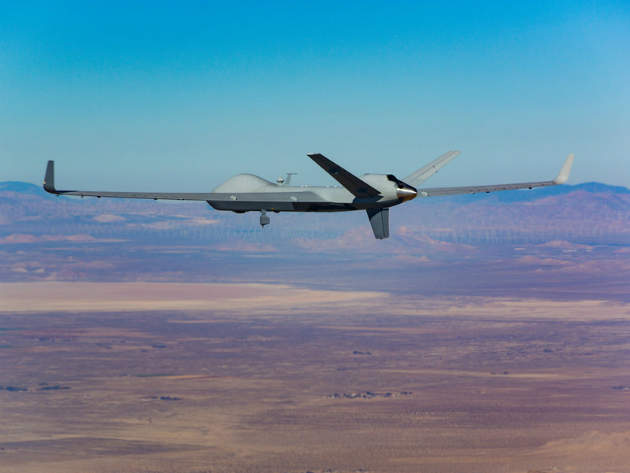
The UK Ministry of Defence’s (MoD) plans for acquiring the next-generation Certifiable Predator B UAS will deliver a step change in the ability of the British armed forces to meet current and future threats. The UK requested a sale of up to 26 Certifiable Predator B UAS in a foreign military sale from the US Government in November 2016.
At an estimated cost of $1bn, the new fleet will provide improved intelligence, surveillance and reconnaissance (ISR) coverage to enhance homeland security, promote increased battlefield situational awareness, augment combat search and rescue, and provide ground troop support.
The Certifiable Predator B – so called because of its full compliance with NATO’s UAV System Airworthiness Requirements (defined in STANAG 4671) and the UK DEFSTAN 00-970 certification specification – is being developed by General Atomics Aeronautical Systems (GA-ASI). The UAS is a variant of the highly successful and widely deployed Predator B that is being designed to operate under the stringent airworthiness requirements of non-military airspace.
Called the SkyGuardian by GA-ASI, the UAS will be known as Protector in UK service and be capable of undertaking missions in excess of 35 hours at airspeeds of up to 210kts, and altitudes of more than 14,000m.
It will carry a variety of sensor and communications payloads and will be capable of transmitting high-resolution video to manned aircraft and ground forces. The maritime patrol variant is designed to support open ocean and littoral surface surveillance for border patrol, coast guard, and disaster relief missions.
High-tech capabilities of the Protector UAS
The UK’s Protector aircraft will carry advanced imaging and enhanced datalink technology. Specifically, the FMS request included 25 multi-spectral targeting systems, 25 AN/APY-8 Lynx IIe Block 20a synthetic aperture radar and ground moving target indicators (SAR/GMTI), 86 embedded global positioning system/inertial guidance units (EGIs), communications equipment, and identification friend or foe equipment.

US Tariffs are shifting - will you react or anticipate?
Don’t let policy changes catch you off guard. Stay proactive with real-time data and expert analysis.
By GlobalDataIn December 2016, Defence Secretary Michael Fallon committed a further £100m to the development of UK-specific imaging and datalink technologies, and for armament integration, which is planned to be the Brimstone precision strike missile, and Paveway IV laser-guided bombs.
MBDA is currently working on the Brimstone programme, and will work together with the UK and the US to integrate the weapon and conduct trials and firings by 2020. The weapon will give the UAS the capacity to defeat fast moving, manoeuvring targets.
The road to certification
To facilitate qualification testing, GA-ASI is building three company-owned aircraft, along with two airframes designed specifically for full-scale fatigue and static testing to satisfy type-certification requirements.
The development programme is progressing well. The first type-certifiable Predator B completed its first flight in late November 2016. Qualification testing for type certification will continue over the next two years, with the first production aircraft currently planned for delivery to the UK Royal Air Force (RAF) in 2018.
“The focus for the 2017 development programme is to release all aircraft drawings, complete the ground control station concept design review, expand the aircraft envelope, complete 50% of the DO-178 software artifacts and build the full-scale-static test article”, said Mike Cannon, vice president of international programs for aircraft systems at GA-ASI. “[We will also] execute the UK Protector direct commercial sale contract.”
He offers a breakdown of the next steps in the programme: “One, continuous flight testing of the first prototype aircraft at Yuma Proving Grounds to test and learn more about the as-built capabilities, including an endurance flight. Two, final design and build of a certifiable ground control station prototype; and three, assembly of a production representative, second prototype aircraft to support development and test.
“Four, execute the UK Protector programme to design the unique configuration requested by the UK MoD. via the direct commercial sale), in preparation for the expected contract with the US Air Force for a foreign military sale of 16 Protector aircraft and seven ground control stations.”
Embracing unmanned technology
This substantial investment in unmanned technology shows that the British Government remains engaged with the game-changing capabilities it delivers. With the option to acquire up to 26 Protector UAS under the foreign military sale, the new fleet will be more than double the size of the ten-strong MQ-9 Reaper UAS fleet it replaces. This enlarged fleet will significantly increase the UK’s ability to identify, track, deter and ultimately counter potential threats.
Following the publication of the 2015 Strategic Defence and Security Review (SDSR) in which the government’s plans for Protector where initially announced, UK think tanks applauded the decision to essentially reverse the approach of the 2010 SDSR.
In her commentary following the 2015 SDSR, Elizabeth Quintana, senior research fellow for futures and technology at RUSI, said:
“The RAF’s ISR fleet was heavily cut in the last SDSR, only for the government to realise that this was one of the military’s greatest contribution to allies and partners on current operations. The Reaper fleet has never stopped working and is now operating at three times the rate outlined in planning assumptions.
“Long-term investment in the ISR fleet is therefore very welcome and a testament to the work of the RAF and Joint Forces Command to protect and enhance these joint enablers. As a consequence, the RAF has also announced a doubling of its armed remotely piloted air systems by 2020, and extensions to its Sentinel, Sentry and Rivet joint fleets out to the 2030s. There are also rumours of investment in the UK-designed Zephyr near-space remotely piloted air system, which would have the ability to remain aloft for weeks at a time.”
With the Protector project well underway, this new, bigger and high-technology UAS fleet will provide the necessary boost to the UK’s ISR capabilities, giving UK forces the ability to address sophisticated threats at home and abroad, and enhancing their ability to intervene with speed and precision to protect the country’s interests and those of its international partners.



